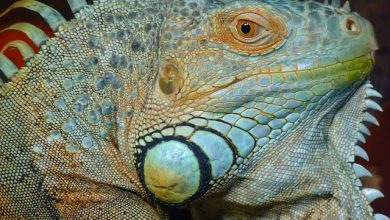How to Choose a Healthy Exotic Pet – The Tye-Dyed Iguana

L
There are few aspects of pet ownership more disappointing than bringing home a new pet from a shop only to discover that itâs already in poor health and doesnât live long after arrival. Thatâs not exactly an ideal experience, especially for an exotic pet that you spend a good amount of money to acquire and prepare for.
Reputable exotic pet shops will inspect the health of their animals regularly. But they donât always catch everything, so you also need to perform your own due diligence before bringing a reptile or amphibian home.
Hereâs what to look for when choosing a healthy exotic pet.
Look for movement
Itâs true that many herps are nocturnal and not particularly active during the day. If you can, try to get a look at the animal you want during a time that it might be up and moving. An animal that is slow or motionless during its normal sleeping hours is not an indication that anything is wrong.
But if you get a look during their waking hours, you want to select an individual that seems to be energetic and moving around. Waking time activity is a decent indicator that the animal is healthy. Overall, youâre looking for normal behavior for the species.
That being said, some species just arenât particularly active. So you should also check out the next indicators.
Check the skin, scales, or shell

Before buying any exotic pet, you always want to ask to handle the animal. Do not buy from any pet shop or breeder who wonât let you handle and examine the animal before buying. There are a few easy-to-spot health indicators found externally on many species.
Check the skin of the animal for any wounds or injuries. For snakes, run your hands along the scales to feel for small bumps that may indicate parasites, and check for any missing scales that may indicate previous injuries or health problems.
When selecting a young tortoise, feel the shell to make sure itâs firm. Thatâs an indication that the animal is getting adequate nutrition and is developing properly.
Check the eyes and nose
While you have the herp out of its tank or cage, check its eyes too. When you check the animalâs eyes, what youâre looking for is to see if they are clear of cloudiness or discharge.
If you spot some cloudy coloration to the eyes, itâs not necessarily an indication that anything is wrong. For species that shed, such as snakes, the eyes can become cloudy as the scales over the eyes (called eye caps) loosen and fall off.
Youâll also want to check the nose for runny discharge. This could be a sign of a cold. Itâs not a huge health concern, but you probably donât want to buy from people who are trying to sell sick animals rather than treating them.
If youâd like to see what normal and healthy behavior looks like in a particular species, come check out the reptiles and amphibians at The Tye-Dyed Iguana. Our team is happy to talk to you about expected animal behaviors.



